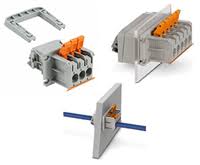- Home
- About
- Products
- Product Testing
- Application
- Services
- Information
- Contact
Views: 2152 Author: Site Editor Publish Time: 2021-04-04 Origin: Site

DESIGN PRINCIPLES OF TERMINALS
Introduction: The article describes how to design terminals.
Terminal is one of the basic electrical components and plays an important role in electrical field. The design of terminal is one of the important factors to determine the quality of terminal, so this paper briefly introduces some basic general principles to be considered when designing terminal.
Terminal is a kind of connector, so we should refer to IEC, UL, CSA, VDE, TU, GB and other standards when designing terminal, and also refer to some industry standards, such as JB,GJB and so on.
The properties of materials directly affect the performance of the whole product, which is the key to design. Take the PA66 material as an example, which is the most widely used plastic material used by most manufacturers. This material meets the fire resistance grade UL94. Design the product according to the physical properties of the material supplied by the manufacturer. CTI parameters of the product must meet the requirements, which will affect whether the final product can pass the impulse voltage resistance test, aging resistance test and other tests. According to the UL standard, the designer can mix the recycled material with the new material after full stirring, but the content of the recycled material can not exceed 25%. For high-current and high-voltage products, the content of recycled materials should be lower or zero.
For the components with on current and elastic, such as the pressing plate of the terminal, the quality of the material directly affects the electrical performance and connection performance of the terminal. Because the conductivity of the material directly affects the temperature up and contact resistance, the quality of elasticity is related to the chemical elements, elastic modulus, hardness, tensile strength of the material. The greater the conductivity of the material is, the smaller the contact resistance and the lower the temperature up are.
Electroplating layer is also the main factor that directly affects terminal life. Taking gold plating and silver plating as an example, the conductivity of silver is higher than that of gold, but its chemical stability is not as good as gold, and the resistance caused by silver plating is much larger than that of gold plating. But the cost of gold plating is high, and gold plating is used only for products that are used in acidic or worse environments. Thermoplastic materials mainly affect the temperature up and contact resistance generated by the terminals in the work. The high temperature caused by the operation of the terminal will make the shell deformed and softened, thus the material of the terminal shell should meet the requirements.
The structure of the terminal should be designed reasonably to ensure the safety of the user. The edges and corners on the shell of the terminal and burrs on the metal parts must be treated to prevent damage to the user. All parts that the operator can touch should be uncharged and the terminals inside the shell should not be touched. The screws need to be very reliable to prevent the wire from accidentally loosening and causing short circuit.